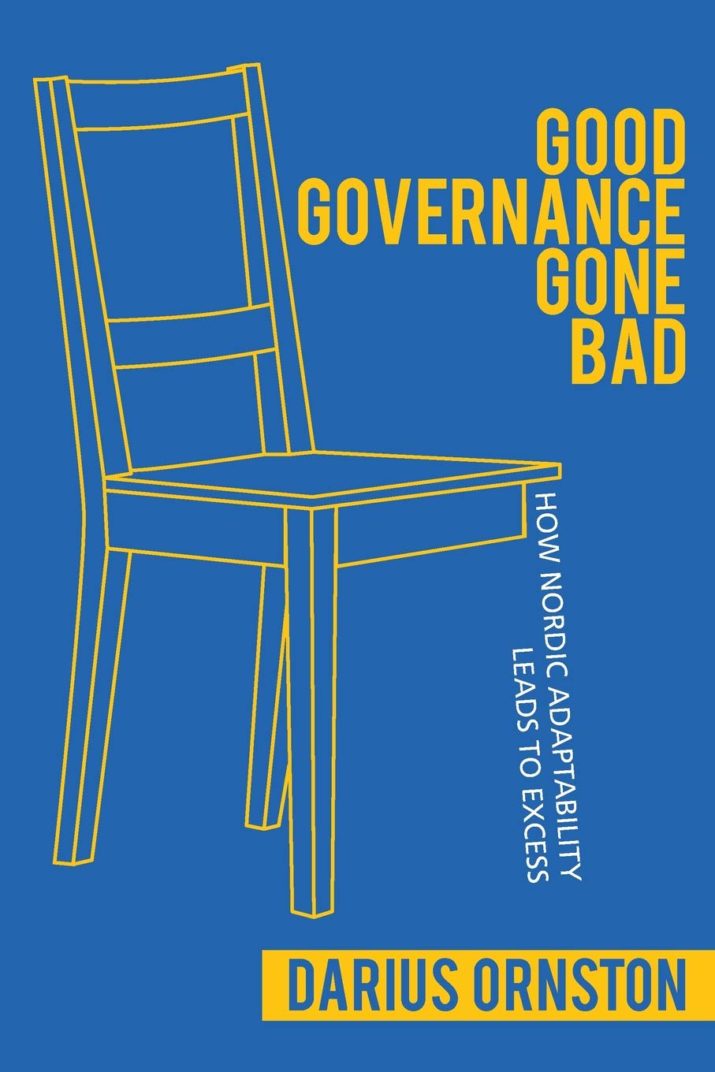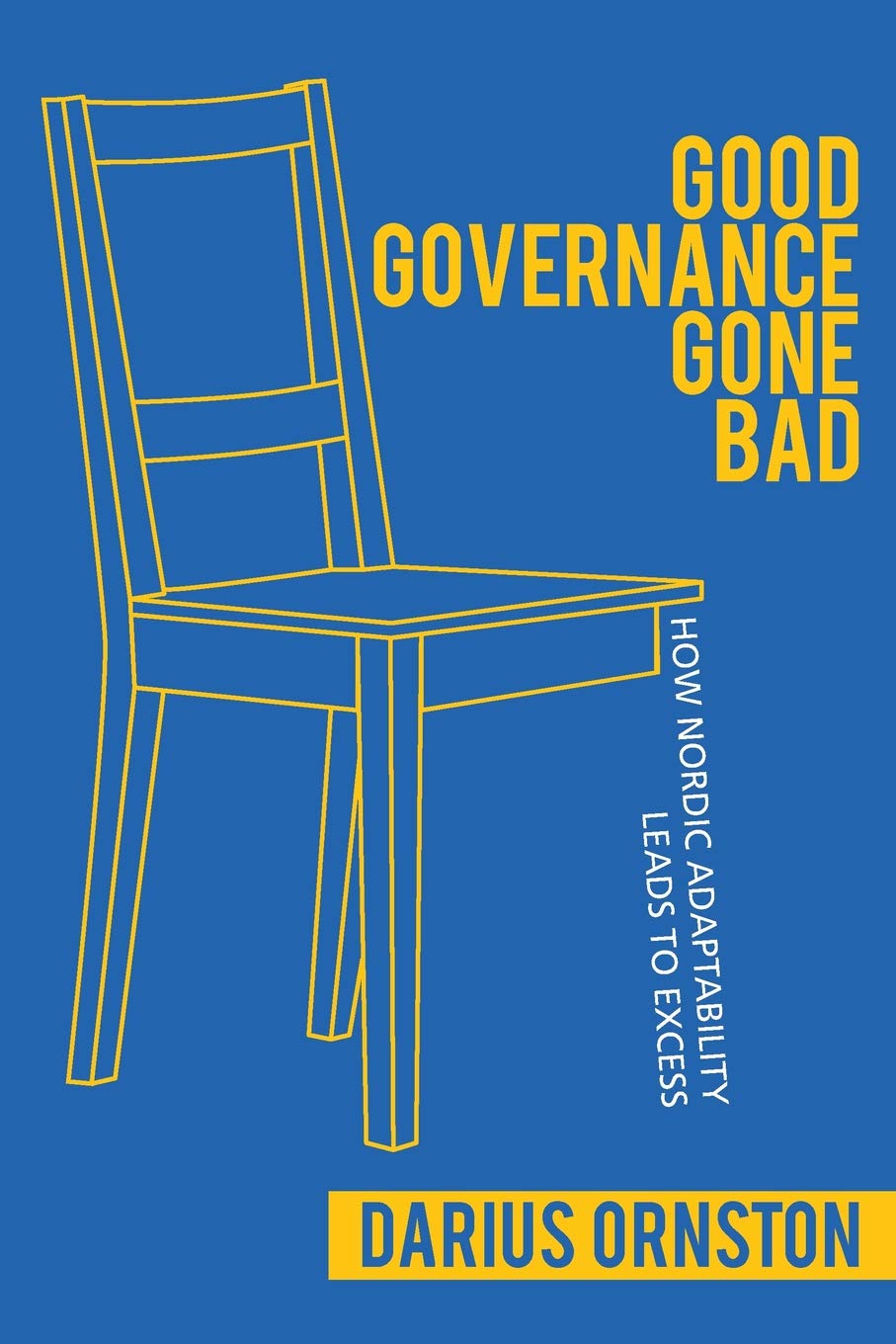

Recurring references to various Nordic nations’ politics and policy, in both scholarly articles and the popular press, suggest that their “model” still attracts international attention. Most commentaries are positive, some are even well informed, but negative references are certainly part of the picture. Inaccuracies abound in both camps, so a careful, detailed study of the region is always welcome. Darius Ornston has built on years of comparative political economic studies to provide an ambitious if demanding critical study of the region. Moreover, he has extended his analysis to a number of interesting western countries that share some of the characteristics and challenges of the Nordic group.
Good Governance Gone Bad notes the many laudatory studies over the eighty years since Scandinavia managed to moderate the impact of the Great Depression, maintain democratic government, and build successful if expensive welfare states. Contrast this legacy with the region’s recurring economic crises of the past thirty years. Why the change? Ornston examines various theories of political economy, including the “power resources” approach (building on social democratic and labor power), and the “varieties of capitalism,” small state, network, and other approaches. He argues that policy changes in the Nordic countries have been both a response to economic crises (as well as secular economic changes) and a cause of future crises. Across the cases and references, Ornston creates a picture of dynamism and responsiveness that often leads to excess. He calls this “overshooting”—a theme that persists throughout the study. Here, Ornston develops a premise found in most “small state” studies. “Dense ties”—where the elite share close connections, including family, school, military, and friendship ties (sometimes all of the above)—accelerate policy reforms but can lead to overshooting, overinvestment, and economic volatility (11). Although Ornston does not directly reference it, these characteristics are typical of the problem of “groupthink” that was developed in the 1970s by social psychologists, especially William H. Whyte, Jr. and Irving Janis. Whereas Janis, for example, focused on foreign and security decisions, Ornston indirectly applies many of the groupthink ideas to domestic policy choices.
Having established this theoretical orientation, Ornston then moves on to three detailed case studies. Chapter 2, subtitled “Planning in Sweden,” surveys the rise and crises of Swedish industry. For nearly a century, Swedish economic growth was propelled by an innovative and export-oriented manufacturing industry that produced everything from supertankers and automobiles down to ball bearings. In response to crises in the 1930s, Sweden created its comprehensive welfare state, as well as a democratic corporatist economic planning regime. Central to this planning regime were large concentrated finance, industrial firms, and labor unions. The strong state remained through Sweden’s precarious neutrality during World War II and the economic dislocations in the postwar period. Few countries enjoyed the European “Golden Years” (roughly 1948-1973) more than Sweden. Credit rationing, the “solidaristic” (egalitarian) wage policy, heavy investment in export industries, and later housing, placed Swedish living standards among the global top ranks. In the 1970s, however, the combination of the oil crises, financial instability, and rising global competition threatened the Swedish economy. Large industries, such as shipbuilding, were in severe crisis. Still, the rise of information and communications technology (ICT), propelled in part by firms like L.M. Ericsson, opened new opportunities. Alongside the growth of ICT, the powerful Swedish financial sector was liberalized. It expanded first into domestic retail finance and then abroad. Unfortunately, these sectors proved quite volatile, and governmental efforts to stabilize (i.e. plan) were ineffective. Sweden suffered a severe financial crisis in the early 1990s and made significant reforms both in the public and private sectors. After 1976, the forty-year political dominance of the Social Democrats yielded to alternating center-left and center-right governments. Swedish membership in the European Union (after 1995) put further constraints on remaining economic planning institutions.
Ornston’s second detailed case is Finland and focuses on the rise of ICT and telecommunications in the Finnish economy. During the twentieth century, Finland transformed rapidly from an economic backwater, which was mainly rural and dependent on timber, paper, and some mining, to a prosperous and modern advanced industrial society. Along the way, it faced much more political and economic turmoil than Sweden: independence from Russia in 1917, a bloody civil war, shaky government during the interwar global Depression, two wars with the Soviet Union, and the loss of territory and large reparations to the Soviet Union after 1945. The Finns made the best of their difficult situation through strict government regulations, as well as successful exploitation of a stable export market in the Soviet Union and communist Eastern Europe. Typically, 30 percent of Finnish exports went to the USSR, and another 5 percent to other communist countries (67). Gradually, Finland upgraded its economic competitiveness through investment in educationand research and development, as well as the pursuit of new markets in Western Europe and beyond. In the 1980s, banking regulations were liberalized and a large financial sector grew. Unfortunately, overinvestment, particularly in property, together with the collapse of Finland’s eastern markets, caused a severe economic crisis that sent its GDP down by 11 percent between 1990 and 1993. In the wake of this, the expanding ICT sector became crucial for Finland’s economic stabilization. The most prominent actor here was Nokia—a low-tech firm (tires, galoshes, paper) that became a telecom giant. Unfortunately, after nearly two decades of renewed prosperity and rapid integration into the European Union, Finland’s ICT sector struggled with international competition and the global financial crisis plunged the Finnish economy again into recession. Again, too many eggs were placed in one basket. Nevertheless, Finnish resilience has slowly pushed the economy forward with software, more sober finance, and research and development leading the way.
The saga of Iceland, Ornston’s third case, will be familiar to most readers, but he adds many useful details. Chapter 4’s catchy title, “From Banking on Fish to Fishy Banks” sums up a good chunk of Iceland’s economy during the postwar era. Like Finland, Iceland made the transition from a poor mono-cultural country to a modern Nordic nation. In 1904, Iceland’s per capita income was only 50 percent of Denmark’s. By 1980, it was roughly equal to that of the other northwestern European economies (112). Iceland built this prosperity by restricting fisheries (first to Icelanders and then with quotas), developing “value-added” processing (freezing and rapid transport of seafood to foreign markets), and diversification. Simultaneously, geothermal and hydro energy raised living standards and engendered new industries, such as aluminum smelting and the creation of data centers. Of course, the big story is the amazing growth of the three Icelandic banks, which in 2007 had balance sheets totaling 800 percent of Iceland’s GDP. Not only had they become major factors in the national economy—they dominated public life. Ornston’s detailed account of their growth illustrates the close and closed nature of the small country’s politics, business, media, and finance. Hence when the collapse came in 2008, the country was thrown into economic and political chaos. However, the response was equal to the challenge: austerity was broadly shared, new regulations enacted, and unlike many other countries with financial malfeasance, leading bankers were indicted and, in some cases, convicted of crimes. At this point, Ornston’s study embarks on less detailed but fairly complete investigations of other smaller European countries like Austria, Switzerland, Ireland, and Estonia that have closely tied economic and political elites. Portugal and Greece are included as well, though their coherence with the other cases is less evident. Finally, the broader utility of the concept of “overshooting” is explored via investigations of Germany, France, and the United States. To generalize the approach, Ornston suggests applications to larger urban areas using San Diego, California, and Waterloo, Ontario as examples. This is an ambitious project that leaves open future, detailed investigation.
With its exhaustive survey of the academic and governmental literature and some 335 interviews across these entities, the author has made an important empirical and theoretical contribution. It should be noted that the “groupthink” approach, of which this is a larger example, is already being applied in various policy analyses, including both public and business organizations. What emerges indirectly in Ornston’s study, especially with regard to the Nordic countries (as well as Ireland and Estonia), is the capacity these small countries possess to respond quickly and effectively to crises. The author does not fully develop this aspect. In fact, none of the countries profiled here seem to have been paralyzed by political gridlock. While it would have been much better to have a more open and critical policy-making milieu, the effective response and ensuing reforms and policy changes compare favorably to larger polities. Whatever their issues, the Nordic countries, characterized by continued economic prosperity and political effectiveness, contrast favorably with many larger (and smaller) countries. This study of “adaptability” suggests that the Nordic countries’ policies have occasionally “gone bad,” but their ability to respond effectively is still worth studying—and carefully emulating.
Eric S. Einhorn is Professor Emeritus of Political Science and Adjunct Professor of Scandinavian Studies at the University of Massachusetts Amherst. His scholarship has appeared in Political Science Quarterly, Scandinavian Studies, and the Journal of Contemporary History. He is also the author of Modern Welfare States: Scandinavian Politics and Policy in the Global Age(with John Logue).
Good Governance Gone Bad: How Nordic Adaptability Leads to Excess
By Darius Ornston
Paperback/ 263 pages/ 2018
Publisher: Cornell University Press
ISBN: 978-1-5017-3017-7




